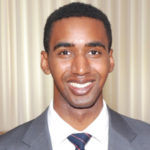Contributor Katie Newton sits down with Boston-based diversity consultant Samuel Ellison for a candid and wide-ranging talk about workplace inclusion, including disability and autism hiring. Ellison builds on his own experiences to help others change the way they view, and act upon, identity and difference at work.

Sam grew up in suburban Philadelphia before attending Villanova University as a student-athlete and writer for the university paper. As a person of color in a predominantly white environment, he learned to work with people different from himself. Sam credits being one of the few students at Villanova with the skill set necessary to work and truly converse with people who were different from him as being a catalyst for his current career and passions. As a Fulbright Scholar, Sam attended the University of Birmingham for graduate studies, studying diversity, social policy, and oppressive forces on a global scale. Sam worked as a Senior Administrator for The Partnership, a Boston based consulting firm working to build racially and ethnically diverse professional landscapes before becoming as an independent writer and consultant.
He also trains professionally with the Boston Athletic Association/Adidas as one of the top 800m runners in the United States.
Sam and I began our talk by defining workplace diversity and what a company should aim for to be ethical, balanced, and inclusive. We spoke about concrete steps a company can take, and also what can be done from a more general standpoint to shift our culture toward inclusivity.
Katie Newton: What is workplace diversity?
Sam Ellison: Essentially, what differences exist in the workplace. What I notice in media is that many of us use ‘diversity’ as a noun when it’s actually more of a verb to me—it’s an action. You might think of a diverse individual, or, say, ‘a diverse candidate,’ and that doesn’t fully encapsulate what companies should be striving for. Because if you’re looking for a person or a place or a thing, that doesn’t help you to do more of a culture shift.
KN: What about the value of diverse working environments? Why is it important?
SE: All sorts of studies show how much more—not only how much more profitable your companies can be—but how much more innovative your company or team can be. Because you’ve got different people coming from different perspectives. The challenge, of course, is trying to hire and foster all those perspectives in one place. And making sure that folks don’t feel, or minimize the extent they feel, tokenized or othered, or seen as providing some sort of information that that company hasn’t been able to access without greater heterogeneity. So, in sum, diversity just means difference, and, how do you manage all those differences in a particular place?
KN: Can you help our readers get a sense of how they would know whether they or their companies are achieving diversity? Are there any specific things they can look for?
SE: Ask yourself, wherever you are, whether it’s in a company environment or in a social one, ‘who isn’t present?’ If you’re accustomed to having just one type of person in the workplace, you won’t be aware of the different mindsets, skill sets, and how that would actually help you.
KM: Important question. Are there other tools or resources that are helpful?
SE: If you’re in an industry like the STEM industries—they are often white dominated, they’re often dominated by men. A good place to start is to go towards what is actually representative in this country. And, you can go father and say, ‘are there ways we can go a bit deeper and go past those numbers?’ Because I think the other challenge is even if your company, or your organization, or team, doesn’t look diverse, it’s actually more about ‘what sort of guiding principles are we using to function in this office or this workplace?’
KM: So you’re talking about demographics, and using demographics to gauge how well you’re hiring reflects the actual make-up of the community.
SE: Yes, but not demographics alone.
KM: What about for industries that are mostly dominated by one gender, or one socioeconomic background, one neurotype? There’s a perception that it can be hard to find someone who “breaks the mold” to even consider hiring.
SE: There’s always more people than we think there are. Are the directors consistently going to the same college fairs and networking at the same events in order to recruit? Can relationships be fostered with schools that have higher numbers of minority groups? Can someone be brought onto the team who might not have the exact same level of degree but who has the skill set that can be fostered and grown within the job setting? Are they always interviewing in the same way? If the certain industry has very low numbers of different types of people pursuing the career, the issue may be systemic, and one company is not going to necessarily change the way young people see their field or aspire to become a certain type of worker. However, by increasing these differences within the workplace, the greater hope is that younger people will see themselves represented in these industries, and over time, their goals and aspirations will change and some of the barriers keeping them from attending certain universities or seeing themselves in a certain role will fade.
KM: Thanks, Sam. You’ve given us a lot to think about. We’ll pick up this conversation in subsequent posts, but I want to give readers a chance to digest this info and chime in with any questions or comments!
SE: Thanks, Katie.
Readers, do you have questions for Katie or Sam? Join the conversation.
You Might Also Like:
The Push for Neurodiversity: Six Reasons to be Hopeful About Job Prospects for Autistic Students
College, Autism & STEM Careers: Participation, Barriers, and Solutions
Finding the Right Fit: Good Tech Internships and Jobs Empower Autistic Students
How Greater Autism Representation Positively Impacts the Workplace




